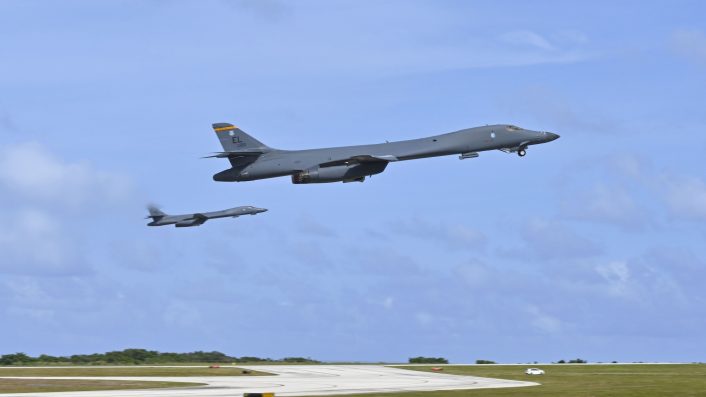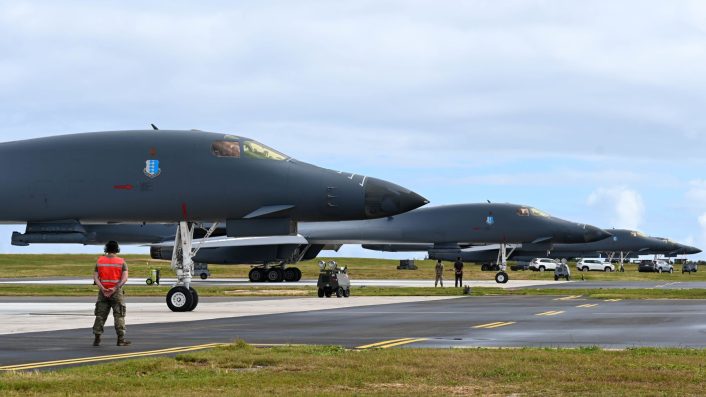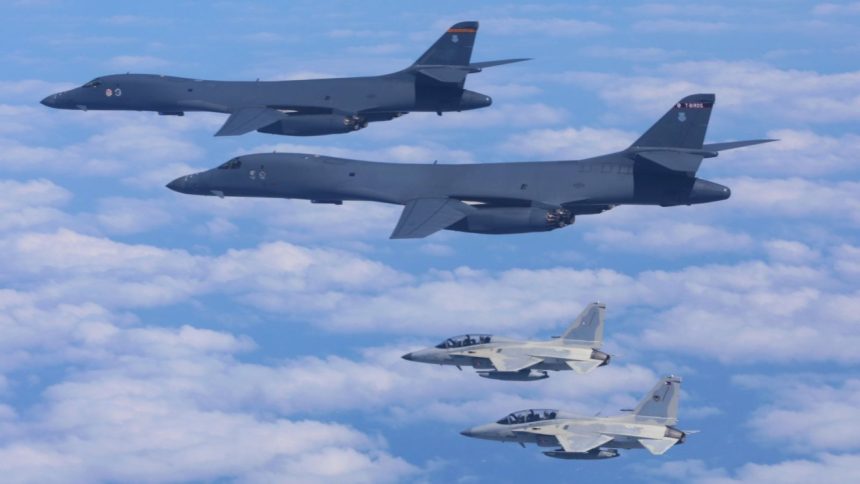U.S. and Philippines aircraft have been involved in a series of bilateral exercises, which this time saw FA-50 light fighters and B-1B bombers flying over the disputed Scarborough Shoal/Bajo de Masinloc.
In a bilateral exercise, two U.S. Air Force B-1B bombers flew with two PAF (Philippine Air Force) FA-50 fighters over the West Philippine Sea on Feb. 4, 2025. The PAF described it as a “Joint Air Patrol and Air Intercept Training,” adding that it was around the disputed Scarborough Shoal, contested by both Philippines and China.
Three PAF FA-50PH participated in the exercise, as seen in a video showing their departure from an unspecified base. The third FA-50 cannot be seen in the in-flight video, however it could be assumed it was possibly used to photograph and record the video during the flight. The FA-50s, the most advanced and the latest jets in the PAF fleet, were flying in a clean configuration, with only external fuel tanks on its innermost and centerline hardpoints.
The bombers are part of the first BTF (Bomber Task Force) mission of 2025 in the Indo-Pacific theater, BTF 25-1, at Guam’s Andersen AFB (Air Force Base). Four BONEs (as the B-1 is called by its crews) from the 34th Bomb Squadron (34th BS) landed there between Jan. 15 to Jan. 17, 2025 as a part of the BTF. While on their way to Guam, two of the B-1Bs also conducted a trilateral flight with Japanese and South Korean fighters on Jan. 15.
PAF NEWS | PAF-PACAF CARRY OUT JOINT AERIAL EXERCISES IN THE WEST PHILIPPINE SEA
See full article 👇 https://t.co/wZLs5W4MJr pic.twitter.com/NIxLnrDZGR
— Philippine Air Force (@PhilAirForce) February 4, 2025
Flight around the disputed Scarborough Shoal
Philippine news outlets posted a clip of a press interaction, where Col. MA. Consuelo Castillo said that the route within which the formation flew included Bajo de Masinloc, the Philippine name for the Scarborough Shoal, which is “part of our territory,” said the official. “We are doing this training based on international rules-based order, protocols and will continue regardless of the action of other foreign actors,” Castillo added.
“The exercises focused on enhancing operational coordination, improving air domain awareness and reinforcing agile combat employment capabilities between the two air forces,” the Philippine Air Force added. PACAF (Pacific Air Forces) said that the joint air patrol and air intercept exercise was “aimed to enhance our coordination and refine strategies together for a free and open Indo-Pacific.”
 Two USAF B-1B Lancers assigned to the 34th Expeditionary Bomb Squadron from Ellsworth AFB, South Dakota perform a dual takeoff from Andersen AFB, Guam on Jan. 29, 2025, in support of Bomber Task Force 25-1. (Image credit: USAF/ Senior Airman Brittany Kenney)
Two USAF B-1B Lancers assigned to the 34th Expeditionary Bomb Squadron from Ellsworth AFB, South Dakota perform a dual takeoff from Andersen AFB, Guam on Jan. 29, 2025, in support of Bomber Task Force 25-1. (Image credit: USAF/ Senior Airman Brittany Kenney)The PAF itself is enhancing its own tactical and equipment capabilities, with a first-of-its-kind exercise integrating its A-29B Super Tucanos and U.S. Air Force A-10 Warthogs, while also buying additional FA-50s and A-29Bs. Additionally, the drills come after China released a map, in Nov. 2024, declaring “baselines” of its territorial sea adjacent to the Scarborough Shoal/Bajo de Masinloc. It was not clear if the latest PAF and USAF exercise faced any opposition or warnings from People’s Liberation Army Air Force or Navy aircraft.
YOUR AIR FORCE IN ACTION | Two PAF FA-50 fighter aircraft in flight formation with two U.S. PACAF B-1 aircraft during the joint Air Patrol and Air Intercept Training over the West Philippine Sea on February 4, 2025. pic.twitter.com/g9rq1hopeD
— Philippine Air Force (@PhilAirForce) February 4, 2025
U.S. and Philippines exercises
While it is not clear how long the BTF 25-1 will last, with the standard duration being two to four months, the B-1Bs will very likely participate in set drills with South Korea, Japan, Australia and other regional partners, including the Philippines. The latest exercises with the PAF around the disputed features of the Scarborough Shoal would be the first in a long line of maneuvers to deter China.
The Philippines has also been involved in other large-scale exercises with the U.S., including the BALIKATAN series of drills. The 2024 iteration saw an AC-130J gunship destroy a small sea target representing a small fishing boat for the first time. Given its small air force, the nature of Philippines and U.S. aerial drills would be limited, while they would be more expansive with ground and amphibious forces, including HIMARS (High-Mobility Artillery Rocket System).
 USAF Senior Airman Christopher Crespo, 34th Expeditionary Bomb Squadron engines journeyman, awaits the queue to begin taxi procedures prior to multiple B-1B Lancers taking off in support of BTF 25-1 at Andersen AFB, Guam, Jan. 27, 2025. (Image credit: USAF/Airman 1st Class Alec Carlberg)
USAF Senior Airman Christopher Crespo, 34th Expeditionary Bomb Squadron engines journeyman, awaits the queue to begin taxi procedures prior to multiple B-1B Lancers taking off in support of BTF 25-1 at Andersen AFB, Guam, Jan. 27, 2025. (Image credit: USAF/Airman 1st Class Alec Carlberg)For instance, during the same BALIKATAN exercises, the U.S. Army employed the HIMARS from a Philippine-controlled island in an “HIRAIN (HIMARS Rapid Infiltration Mission) and live-fire event, according to the INDOPACOM (Indo-Pacific Command). The HIMARS was loaded onto an MC-130J Commando II transport aircraft in Subic Bay before inserting into San Vicente, Palawan. From there, the HIMARS, along with artillery from the Philippine Marine Corps, embarked on “a landing craft, air-cushioned to transition to the USS Somerset to continue their movement down the coast of Palawan overnight.”Indo-Pacific Command
In another first such exercise, held between Jun. 15 and Jun. 21, 2024, four U.S. Marine Corps F-35B Lightning IIs dropped seven GBU-32 JDAMs (Joint Direct Attack Munitions) on “floating targets” off the coast of western Luzon. This was followed by the Philippines’ 3rd Marine Brigade, the USMC’s 15th Marine Expeditionary Unit (15th MEU) and other allies defending a beach from an amphibious assault during exercise KAMANDAG 8 late in Oct. 2024.
The four B-1Bs meanwhile appear to be conducting regular operations from Andersen AFB, with PACAF releasing additional images of their activities towards the end of January. The bombers can be expected to fly with Japanese and South Korean aircraft like the F-15s, F-16s and F-35s over the next few months, and we can expect powerful live-fire components in those drills.









